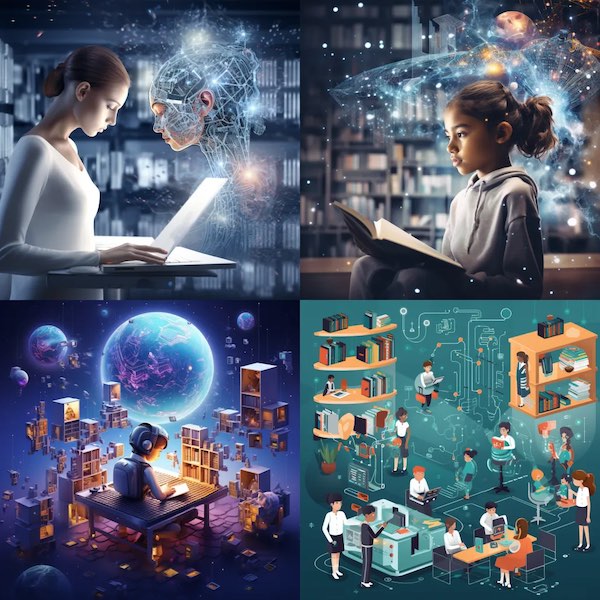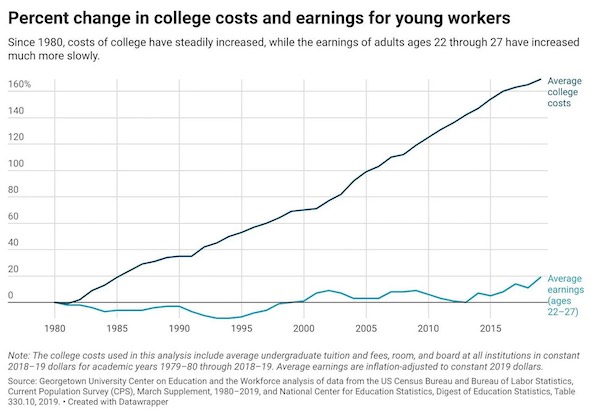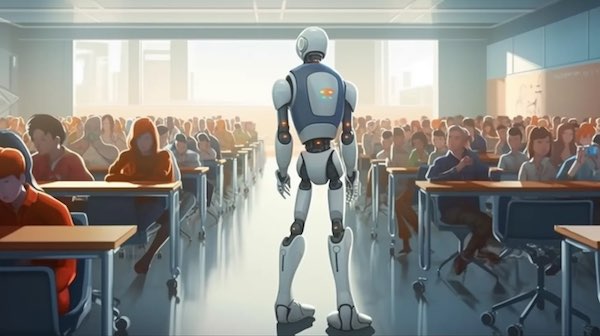Can AI Transform Education in America?
- Category: The Goods
- Published: Wednesday, 12 July 2023 21:18
- Sameer Ahuja
 (Written by Scarsdale Village Trustee Sameer Ahuja)
(Written by Scarsdale Village Trustee Sameer Ahuja)
Party Guest: What are you going to do now?
Benjamin Braddock: I was going to go upstairs for a minute.
Party Guest: I mean with your future…?
Film fans, especially of the Baby Boomer variety, will likely recognize this dialogue from Mike Nichols’ classic The Graduate (1967). During what should be a happy graduation party, our hero Benjamin Braddock (Dustin Hoffman) instead finds himself lost. Confused. Especially as he’s on the receiving end of so many questions surrounding what’s to become of him.
This scene perfectly illustrates the fraught transition from college to the “real world.” Braddock epitomizes the fear and uncertainty surrounding what to do with one’s hard-earned degree.
It seems that no matter who you are, if you’re a young person, you can’t escape this burning question: “So what are you doing with your life?”
Nearly 60 years have passed since the release of this cultural touchstone. Today’s grads may look quite different—suits and ties are out, sneakers are in at family gatherings—but their existential angst hasn’t gone away.
In fact, for today’s young adults, the above question is becoming increasingly harder to answer. Even before ChatGPT threatened to zap so many “safe” white collar jobs, many a grad struggled with how to apply their degree to stable career paths.
In a recent study by ZipRecruiter, some top majors most lamented by students include: journalism, sociology, and education. And while these studies originate from different academic fields, they all have one thing in common: Lack of job prospects.
It’s not the fact that these fields aren’t useful. If anything, with increasing disruption to our information delivery systems and educational institutions, we need more trained experts in these areas. It’s the current ROI on these degrees.
What is the ROI on College Education?
Endless columns have been inked about the discrepancies in quality and accessibility of pre-college education across the U.S. This topic continues to spark heated debate across the country, but less contentious is the enduring reputation of America's higher education system. Among the vibrant tableau of global higher education, U.S. colleges and universities command a bright corner, frequently crowning the upper tiers of global rankings.
These institutions, renowned for groundbreaking research, unparalleled faculty, cutting-edge facilities, and a kaleidoscopic array of courses that inspire intellectual curiosity, serve as more than just a springboard for academic excellence.
Yet, it's the nebulous relationship between the ever-escalating costs of this education and the prospective career outcomes in an accelerating 21st-century world that raises eyebrows and concern alike.

For starters, soaring costs are leading many to question the value of the four-year degree. Our traditional cause-and-effect relationship between a degree and higher earning power is crumbling before our very eyes. And for those who choose to attend, student loans are preventing them from fully participating in our economy.
It’s therefore no surprise that American youth are increasingly considering eschewing the college path, opting instead for more practical, job-specific education. Especially men. As this Breaking Points segment reveals, males are fleeing universities. By the millions.
Meanwhile, alternatives like trade schools are exploding in popularity. Real-life experiences and skill-specific training are also gaining prominence, offering yet another path to success. This comes at a time when we could use all the mechanics and engineers we can get—the subject of a recent CAO article.
But this is not just some blue-collar revolution.
Today’s knowledge workers are also questioning college’s value. Especially since marquee employers like IBM, Accenture, and Bank of America have all dropped requirements for four-year degrees, citing labor shortages and their ability to train entry-level personnel on the job.
Simultaneously, companies like Google are investing millions in targeted employee education and online certification programs. These offerings are also more affordable and require less commitment than four years at school—often the monetary equivalent of taking out a home mortgage.
All this points to one inescapable truth: In our quickly evolving economic landscape, a plurality of options exist to answer our initial query: “So what are you doing with your life?”
How Has Tech Impacted Education?
There has been an explosion of tech in education. Virtual classes and remote learning are here to stay, enabling a more personalized curriculum. Cutting edge VR also offers immersive learning experiences that were the stuff of The Jetsons’ back in the ‘60s.
Digital learning platforms have gained incredible traction. In a rapidly changing world, online platforms are not only serving the education needs of young students but also offering a multitude of opportunities for adults seeking continuous learning. For example, Khan Academy, has attracted over 130 million learners. Digital learning platforms like Coursera and Udemy provide a plethora of courses, from marketing to coding, that enable professionals to keep their skills up-to-date or pivot their careers entirely. These platforms offer a self-paced, customized learning experience, enabling students to grasp concepts at their own speed. The shift toward lifelong learning is being recognized as a necessity, given the pace of technological change and job market volatility.
Advancements in tech and skills-based learning models challenge the traditional notion of a college education. But they’re not without their faults. Already, we saw how remote learning failed to live up to many of its promises during the COVID-19 school closures.
The revolution is not limited to the U.S. It's unmistakable how technology has revolutionized education in China. Classrooms have been transformed with the advent of digital learning, with platforms like VIPKid and TAL Education stepping up to the plate. These platforms have been game-changers, providing top-tier educational resources even to students tucked away in the most remote corners of the country. But the real driving force behind this shift was the Chinese government's "Internet Plus" strategy, a catalyst that set the edtech scene ablaze with startups and investments. Fast-forward to today, AI-powered platforms like Squirrel AI are redefining what personalized learning means - adapting and evolving with every student. And as if this isn't exciting enough, China's 2020 New Infrastructure Initiative is pouring resources into 5G technology and AI. This sets the stage for next-gen learning experiences, where virtual and augmented reality step out of the realms of science fiction and into the classroom.
What About AI and Education in the US?
In the ever-evolving landscape of American education, AI emerges as a beacon of hope, potentially reshaping the terrain and fostering equitable opportunities. Here's why it's a cause for optimism, especially for those who've been kept at the periphery of quality education, courtesy of age-old systemic hurdles.
First off, let's acknowledge the elephant in the room - the daunting disparities in U.S. education tied to geography and economic status. Undoubtedly, low-income areas and their schools often get the short end of the stick - limited resources, teeming classrooms, and a dearth of well-trained educators. But here's where AI flexes its muscles. Imagine AI-powered e-learning platforms, dishing out tailor-made, top-notch educational content to every student, without any regard for their location or their school's fiscal health. Sounds like a revolution, doesn't it? Will we really have AI-powered instructors? Actually, Harvard is already rolling them out.
Consider AI tutors, not constrained by classroom capacity or teacher-student ratios, but focused solely on individual instruction. Every student gets personalized attention, with AI seamlessly adapting to each learner's unique style, strengths, and areas of improvement. Suddenly, the daunting challenge of large student-to-teacher ratios in underfunded schools looks less intimidating. Marc Andreessen, co-founder of A16Z says:
“Every child will have an AI tutor that is infinitely patient, infinitely compassionate, infinitely knowledgeable, infinitely helpful. The AI tutor will be by each child’s side every step of their development, helping them maximize their potential with the machine version of infinite love.”
 AI's potential isn't confined to personalization. It's also a gateway to an almost infinite expanse of resources. Think of a student diving into an ocean of knowledge, where AI-driven educational platforms offer everything from intricate math puzzles to intriguing historical narratives. It's like having an expansive, limitless library, always at their disposal.
AI's potential isn't confined to personalization. It's also a gateway to an almost infinite expanse of resources. Think of a student diving into an ocean of knowledge, where AI-driven educational platforms offer everything from intricate math puzzles to intriguing historical narratives. It's like having an expansive, limitless library, always at their disposal.
For students grappling with English as a second language, AI dons the hat of a patient and effective language coach. AI-powered apps can offer instant translations and language lessons, empowering students to fully engage in classroom discussions and absorb curriculum content seamlessly. What if you could read and comprehend three books per day with an AI-assisted reader, helping you fly through chapters in a fraction of the time?
Another ace up AI's sleeve is its ability to detect learning difficulties early. By constantly evaluating a student's performance and detecting anomalies, AI can signal potential problems before they snowball into unmanageable hurdles. This proactive approach can be a lifeline for students who risk being lost in crowded classrooms where personalized attention is a rare commodity.
Of course, the path to harnessing AI's full potential isn't without its obstacles, with the digital divide being a prominent one. To make AI a universal educational tool, we need to bridge this gap. That's where collaborations between tech giants, governmental entities, and education institutions can play a significant role, ensuring even the underprivileged have the necessary tech infrastructure and internet access. The goal? A digital device and reliable internet service for every child, irrespective of their economic background.
Yes, there's much ground to cover before AI can fully realize its potential in education, but the journey seems promising. With careful planning and execution, AI could emerge as a crucial ally in the pursuit of equal educational opportunity for all U.S. students.
No matter what happens next, AI heralds an exciting era where we may shed the one-size-fits-all educational model, allowing students a more self-determined path focused on personalized goals.
What Does This Mean for Traditional Education?
Just like our preference-based entertainment algorithms, AI-driven systems can adapt to individual learning styles, providing tailored instruction, enhancing educational outcomes. This begs a different question: While the full impact of AI in education is yet to be realized, might it democratize the whole endeavor, producing a nation of autodidacts—or self-taught individuals?
 Sameer AhujaA transition to a more decentralized model of education comes with its own challenges. Ensuring quality and consistency in a system where everyone is following their own educational path can be difficult. The role of the teacher is also evolving, from a primary source of knowledge to a facilitator guiding students on their personalized learning journeys.
Sameer AhujaA transition to a more decentralized model of education comes with its own challenges. Ensuring quality and consistency in a system where everyone is following their own educational path can be difficult. The role of the teacher is also evolving, from a primary source of knowledge to a facilitator guiding students on their personalized learning journeys.
Furthermore, the shift towards more job-specific education raises questions about social mobility. As students start specializing early, they could find themselves tied to specific industries or career paths, which might restrict their ability to shift gears in an unpredictable economy. The flexibility that comes with a broader, liberal arts education may be missing in this new paradigm.
As we navigate this era of profound change, one thing is for certain—more uncertainty. And while it’s normal for young adults to feel the many doubts evidenced by Benjamin Braddock, it's also vital we ensure learners are equipped with skills to thrive, not just survive, in our fascinating new world.














